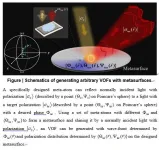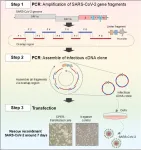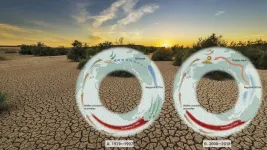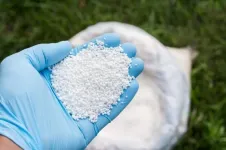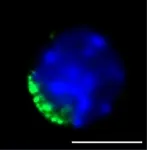Reducing ocean acidification by removing CO2: Two targets for cutting-edge research
2021-04-13
(Press-News.org)
Is it possible to simultaneously address the increase of the concentration of carbon dioxide (CO2) in the atmosphere and the resulting acidification of the oceans? The research of the project DESARC-MARESANUS, a collaboration between the Politecnico di Milano and the CMCC Euro-Mediterranean Center on Climate Change Foundation, explores the feasibility of this process, its chemical and environmental balance, and the benefits for the marine sector, focusing on the Mediterranean basin.
It is now widely recognized that in order to reach the target of limiting global warming to well below 2°C above pre-industrial levels (as the objective of the Paris agreement), cutting the carbon emissions even at an unprecedented pace will not be sufficient, but there is the need for development and implementation of active Carbon Dioxide Removal (CDR) strategies. Among the CDR strategies that currently exist, relatively few studies have assessed the mitigation capacity of ocean-based Negative Emission Technologies (NET) and the feasibility of their implementation on a larger scale to support efficient implementation strategies of CDR.
The ocean plays a particular role in the climate system acting as significant sink of atmospheric heat and CO2; this has caused the additional hazard of ocean acidification, that is the pH reduction of ocean seawater since the pre-industrial period, that is unprecedented in the last 65 million years and has significant implications for marine organisms affecting their metabolic regulation and capability to form calcium carbonate, destabilizing the ecosystem and ultimately threatening vital ecosystem services.
Among the ocean-based NETs, artificial ocean alkalinization via the dissolution of Ca(OH)2, known in short as ocean liming, has attracted attention due to its capability of contemporarily addressing two issues: global warming via increased levels of CO2 and ocean acidification.
A new study recently published in Frontiers in Climate explores the case of ocean alkalinization in detail.
The research, realized by the Euro-Mediterranean Center on Climate Change Foundation (CMCC) and the Politecnico di Milano within the Desarc-Maresanus project, with the financial support of Amundi and the collaboration of CO2APPS, presents an analysis of marine alkalinization applied to the Mediterranean Sea taking into consideration the regional characteristics of the basin.
Researchers used a set of simulations of alkalinization based on current shipping routes to quantitatively assess the alkalinization efficiency via a coupled physical-biogeochemical high-resolution model (NEMO-BFM) for the Mediterranean Sea (1/16° horizontal resolution that is ~6 km) under an RCP4.5 scenario over the next decades.
The alkalinization strategies applied in this study to the Mediterranean Sea illustrate the potential of ocean alkalinization to mitigate climate change by increasing the air-sea flux of CO2 across the basin and counteracting acidification. In contrast to previous studies, the analyzed scenarios offer a clear pathway into practical implementation being based on realistic levels of lime discharge using the current network of cargo and tanker shipping routes across the Mediterranean Sea.
The simulations used in the study suggest the potential of nearly doubling the carbon-dioxide uptake rate of the Mediterranean Sea after 30 years of alkalinization, and of neutralizing the mean surface acidification trend of the baseline scenario without alkalinization over the same time span.
A more recent paper carried out within the project and just published, realizes an estimate of the potential of maritime transport for ocean liming and atmospheric CO2 removal, highlighting a very high potential discharge of slaked lime in the sea by using the existing global commercial fleet of bulk carrier and container ships. For some closed basins, such as the Mediterranean Sea where traffic density is relatively high, the potential of ocean alkalinization, also with low discharge rates, is far higher than what is needed for counteracting ocean acidification. Therefore, the results of this study highlight from one hand the need for further research for a more precise assessment of the technical aspects of this approach and potential criticalities, from another hand indicates the potential of a regional implementation of ocean liming to the Mediterranean Sea based on the existing network of tankers and cargo ships.
"These two publications provide a key contribution to the international and national scientific and technical communities working to find solutions to these two issues - atmospheric CO2 removal and counteracting ocean acidification - which we will have to tackle in the future. Even if further investigations are needed, these results are encouraging", states Stefano Caserini, Professor of Mitigation of Climate Change at Politecnico di Milano and Project leader of the project Desarc-Maresanus.
"In these works the idea of ocean alkalinisation as a mitigation strategy for climate change is for the first time assessed on the base of a technically feasible pathway of implementation providing a first step towards a real-world application. In addition, even if the full ecological consequences of this strategy still require additional research, a solution is indicated that may stabilise the acidity of the seawater counteracting acidification without risking dramatic alterations of the seawater chemistry in the opposite direction, which as of today would have largely unknown consequences." states the main author of the first article, Momme Butenschön, Lead Scientist of the Research Unit on Earth System Modelling at the CMCC Foundation Euro-Mediterranean Center on Climate Change (CMCC).
Read the full papers published in Frontiers in Climate:
Butenschön M., Lovato T., Masina S., Caserini S., Grosso M. (2021), Alkalinization Scenarios in the Mediterranean Sea for Efficient Removal of Atmospheric CO2 and the Mitigation of Ocean Acidification. Frontiers in Climate – Negative Emission Technologies, volume 3, 11 pages, DOI: 10.3389/fclim.2021.614537
Caserini S., Pagano D., Campo F., Abbá A., De Marco S., Righi D., Renforth P., Grosso M. (2021) Potential of maritime transport for ocean liming and atmospheric CO2 removal. Frontiers in Climate – Negative Emission Technologies. 3:575900. https://doi.org/10.3389/fclim.2021.575900
Website: www.desarc-maresanus.net
[Attachments] See images for this press release:
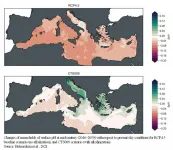
ELSE PRESS RELEASES FROM THIS DATE:
2021-04-13
A five-year study of mule deer does and newborn fawns in western Wyoming shows that migrating deer have a lot to balance when it comes to birth timing.
The study led by University of Wyoming scientists challenges the long-held assumption that animals match offspring birth with the peak green-up of forage at the birth site. Instead, only deer that migrated long distances and followed the flush of spring green-up from low elevation winter ranges to higher-elevation summer ranges were able to match birth with peak green-up. Other deer migrated shorter distances and gave birth earlier, but birth was out of sync with green-up.
The researchers' work appears in the journal Ecology.
To ...
2021-04-13
Light beams are widely used in photonics applications and attracted immense research interests. Compared to homogeneously polarized light beams, vectorial optical fields (VOFs) with tailored wave-fronts and inhomogeneous polarization distributions exhibits more advantages in applications comparing to their scalar-wave counterparts, thanks to the added degree of freedom (DOF) of polarization. By tailoring the polarization distributions, special VOFs such as flap-top beams and radially polarized beams can be generated, being highly favored in super-resolution microscopy, optical manipulations, etc.
Despite of great advances in applications, generation of such complex VOFs are far from satisfactory. Available methods ...
2021-04-13
In a study published in Applied Materials Today, researchers from Singapore have developed the largest range of silicone and epoxy hybrid resins for the 3D printing of wearable devices, biomedical equipment, and soft robotics. The range of tunable functionally graded materials, which displayed over five orders of magnitude of elastic modulus, demonstrated excellent interfacial toughness, higher precision in complex structures and better fabrication control for the integration of mechatronic components.
The multi-disciplinary team from the Singapore University of Technology and Design (SUTD) highlighted the issue on the potential of soft robotics being limited in its robustness and ...
2021-04-13
Osaka, Japan - SARS-CoV-2 is the virus responsible for the COVID-19 pandemic. We know that mutations in the genome of SARS-CoV-2 have occurred and spread, but what effect do those mutations have? Current methods for studying mutations in the SARS-CoV-2 genome are very complicated and time-consuming because coronaviruses have large genomes, but now a team from Osaka University and Hokkaido University have developed a quick, PCR-based reverse genetics system for analyzing SARS-CoV-2 mutations.
This system uses the polymerase chain reaction (PCR) and a circular polymerase extension reaction (CPER) to reconstruct the full-length cDNA of viral genome. This process does not involve the use of bacteria, which can introduce further ...
2021-04-13
In the 1930s, English climatologist, Sir Gilbert Walker, successfully predicted Indian summer monsoon rainfall (ISMR) based on the relationship between Southern Oscillation and ISMR connected by what is later-called Walker circulation, which is regarded as the first achievement of modern climate prediction with a clear physical mechanism. The Southern Oscillation was also recognized as the atmospheric component of El Nino-Southern Oscillation (ENSO).
However, at the end of the 20th century, a research in Science led by Indian climatologist Krishna Kumar found the significant reverse relationship between ENSO and Indian rainfall has been ...
2021-04-13
Ammonia (NH3) is among the most important chemicals produced by humans and has a promising future in sustainable energy applications besides being used in fertilizer production. Unfortunately, so far, the only realistic way that exists to produce ammonia at an industrial scale is through the Haber-Bosch process. This technique, discovered in the 19th century, is very energy-intensive and environmentally unfriendly; about 2% of the yearly global CO2 emissions come from Haber-Bosch processes.
"Considering the threats posed by global warming, it is high time we swap to an ammonia synthesis route with zero CO2 emissions," says Professor Sangaraju Shanmugam from Daegu Gyeongbuk Institute of Science and Technology (DGIST), Korea. ...
2021-04-13
What started out as a second-year physics project is making its way into Amazon Web Service's (AWS) quantum computing program.
University of Sydney science undergraduate Pablo Bonilla Ataides has tweaked some computing code to effectively double its capacity to correct errors in the quantum machines being designed in the emerging technology sector.
The simple but ingenious change to quantum error correcting code has grabbed the attention of quantum researchers at the AWS Center for Quantum Computing in Pasadena, California, and the quantum technology programs at Yale University and Duke University in the United States.
"Quantum technology is in its infancy, partly because we haven't ...
2021-04-13
CORVALLIS, Ore. - A new study by Oregon State University researchers found that shade provided by solar panels increased the abundance of flowers under the panels and delayed the timing of their bloom, both findings that could aid the agricultural community.
The study, believed to be the first that looked at the impact of solar panels on flowering plants and insects, has important implications for solar developers who manage the land under solar panels, as well as agriculture and pollinator health advocates who are seeking land for pollinator habitat restoration.
The findings, ...
2021-04-13
Durham, NC - When leukemia strikes an older person, it is in part due to the aging of his or her hematopoietic stem cells (HSCs). These immature cells can develop into all types of blood cells, including white blood cells, red blood cells and platelets. As such, researchers have focused on rejuvenating HSCs as a way to treat leukemia.
A new study released today in STEM CELLS adds much to that level of knowledge by showing that the youthful function of rejuvenated HSCs upon transplantation depends in part on a young bone marrow "niche," which is the microenvironment surrounding stem cells that interacts with them to regulate their fate.
"The information revealed by our study tells us that the influence of this niche ...
2021-04-13
Ancient clues, in the shape of fossils and archaeological evidence of varying quality scattered across Australia, have formed the basis of several hypotheses about the fate of megafauna that vanished about 42,000 years ago from the ancient continent of Sahul, comprising mainland Australia, Tasmania, New Guinea and neighbouring islands.
There is a growing consensus that multiple factors were at play, including climate change, the impact of people on the environment, and access to freshwater sources.
Now, research led by Professor Corey Bradshaw of Flinders University and the Australian Research Council Centre of Excellence of Australian Biodiversity and Heritage (CABAH) has used sophisticated mathematical modelling to assess how susceptible different species were to extinction - and what ...
LAST 30 PRESS RELEASES:
[Press-News.org] Reducing ocean acidification by removing CO2: Two targets for cutting-edge research


